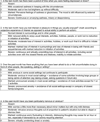Clinimetric testing of the comprehensive cervical dystonia rating scale
- PMID: 26971359
- PMCID: PMC4833533
- DOI: 10.1002/mds.26534
Clinimetric testing of the comprehensive cervical dystonia rating scale
Abstract
Introduction: The aim of this study was to test the clinimetric properties of the Comprehensive Cervical Dystonia Rating Scale. This is a modular scale with modifications of the Toronto Western Spasmodic Torticollis Rating Scale (composed of three subscales assessing motor severity, disability, and pain) now referred to as the revised Toronto Western Spasmodic Torticollis Scale-2; a newly developed psychiatric screening instrument; and the Cervical Dystonia Impact Profile-58 as a quality of life measure.
Methods: Ten dystonia experts rated subjects with cervical dystonia using the comprehensive scale. Clinimetric techniques assessed each module of the scale for reliability, item correlation, and factor structure.
Results: There were 208 cervical dystonia patients (73% women; age, 59 ± 10 years; duration, 15 ± 12 years). Internal consistency of the motor severity subscale was acceptable (Cronbach's alpha = 0.57). Item to total correlations showed that elimination of items with low correlations (<0.20) increased alpha to 0.71. Internal consistency estimates for the subscales for disability and pain were 0.88 and 0.95, respectively. The psychiatric screening scale had a Cronbach's alpha of 0.84 and satisfactory item to total correlations. When the subscales of the Toronto Western Spasmodic Torticollis Scale-2 were combined with the psychiatric screening scale, Cronbach's alpha was 0.88, and construct validity assessment demonstrated four rational factors: motor; disability; pain; and psychiatric disorders. The Cervical Dystonia Impact Profile-58 had an alpha of 0.98 and its construction was validated through a confirmatory factor analysis.
Conclusions: The modules of the Comprehensive Cervical Dystonia Rating Scale are internally consistent with a logical factor structure.
Keywords: Cervical Dystonia Impact Profile-58; Toronto Western Spasmodic Torticollis Rating Scale; cervical dystonia; focal dystonia; rating scale.
© 2016 International Parkinson and Movement Disorder Society.
Figures






References
-
- Jankovic J, Leder S, Warner D, Schwartz K. Cervical dystonia: clinical findings and associated movement disorders. Neurology. 1991;41:1088–1091. - PubMed
-
- Bhidayasiri R. Treatment of complex cervical dystonia with botulinum toxin: involvement of deep-cervical muscles may contribute to suboptimal responses. Parkinsonism & related disorders. 2011;17(Suppl 1):S20–S24. - PubMed
-
- Chan J, Brin MF, Fahn S. Idiopathic cervical dystonia: clinical characteristics. Movement disorders : official journal of the Movement Disorder Society. 1991;6:119–126. - PubMed
-
- Moraru E, Schnider P, Wimmer A, et al. Relation between depression and anxiety in dystonic patients: implications for clinical management. Depress Anxiety. 2002;16:100–103. - PubMed
-
- Wenzel T, Schnider P, Wimmer A, Steinhoff N, Moraru E, Auff E. Psychiatric comorbidity in patients with spasmodic torticollis. J Psychosom Res. 1998;44:687–690. - PubMed
Publication types
MeSH terms
Grants and funding
LinkOut - more resources
Full Text Sources
Other Literature Sources

